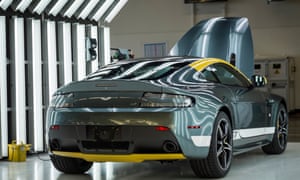Carmaker’s plans for no deal or disorderly exit from EU include £2m for revised supply routes

Aston Martin sold 6,441 cars last year, up 26%, which was better than expected, and it says its special editions were in high demand.
Photograph: David Sillitoe/The Guardian
Aston Martin Lagonda has set aside £30m in preparation for any Brexit-related disruption as the luxury carmaker reported strong revenues in its first set of annual results since its stock market debut.
The company said it was setting aside the cash in readiness for no deal or a disorderly Brexit, including £2m for revised supply chain routes. It has hired a new supply chain chief and has made plans to fly in components or bring them in through naval ports.
Andy Palmer, the chief executive, said a delay to Brexit would be a “further annoyance”. MPs could potentially vote on whether to delay Brexit on 14 March, a fortnight before the scheduled departure date of 29 March. Palmer added: “You’re holding that contingency stock for longer, which means that your working capital is tied up for longer. More importantly, what you’re doing is you’re creating continued uncertainty.”
Revenues at the 106-year-old company, James Bond’s favourite car marque, rose 25% to £1.096bn in 2018. The firm’s disappointing stock market debut in October cost it £136m, which pushed it into an annual pre-tax loss of £68.2m, compared with a profit of £84.5m the year before. Excluding the costs associated with the floatation, Aston Martin made an adjusted profit before tax of £68m.
It sold 6,441 cars last year, up 26%, which was better than expected, and it said its special editions were in high demand. Asia Pacific and the Americas led the way, with volume growth of 44% and 38% respectively, while the UK was up 17% and Europe, Middle East and Africa rose 13%.
The carmaker’s shares have lost more than a third of their value since floating at £19 and fell a further 12.7% to £12 on Thursday, despite the rise in sales. It gives the company a market value of about £2.7bn, down from just above £4bn on its first day of trading.
Laith Khalaf, a senior analyst at Hargreaves Lansdown, said: “On the surface Aston Martin sales are purring away nicely but under the bonnet £136m of exceptional costs, including the costs of its IPO [initial public offering], have left the carmaker in the red for 2018.
“Brexit also casts a shadow, as it does for the rest of the UK car industry, and that may present some big roadbumps in the immediate future if some sort of deal isn’t reached between the UK and the EU.”
The carmaker produced five new models last year: the new Vantage and DBS Superleggera, along with special editions of the sports cars Vanquish Zagato Shooting Brake and Vanquish Zagato Speedster and a remake of the DB4 GT Continuation, which won on its race debut at Silverstone in 1959 when driven by Stirling Moss. The average selling price per vehicle was £141,000, excluding specials, and £157,000, including specials.
Aston Martin will start the first production trial of the crossover model DBX, its first sports utility vehicle, at its new St Athan factory in south Wales between April and June, with full production starting early next year.
The site will also be the centre for battery electric vehicle production and the home of Lagonda and the Rapide E – Aston Martin’s first all-electric production car – which is on track to start production this year.
Catering for a wealthy clientele, Aston Martin is largely immune from some of the pressures the mass-market carmakers are under, such as sluggish consumer demand and the need to invest in electric vehicles.
Palmer said: “As the UK’s only listed luxury automotive group, we have demonstrated our legitimacy in the global luxury market. Our well-defined expansion plans that combine outstanding high-performance cars with iconic brand status are on track as we manage through the uncertainties and disruption impacting the wider auto industry.”